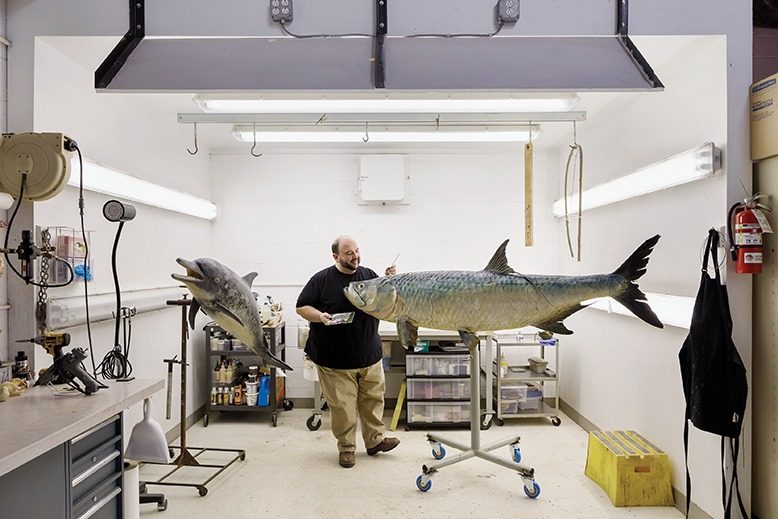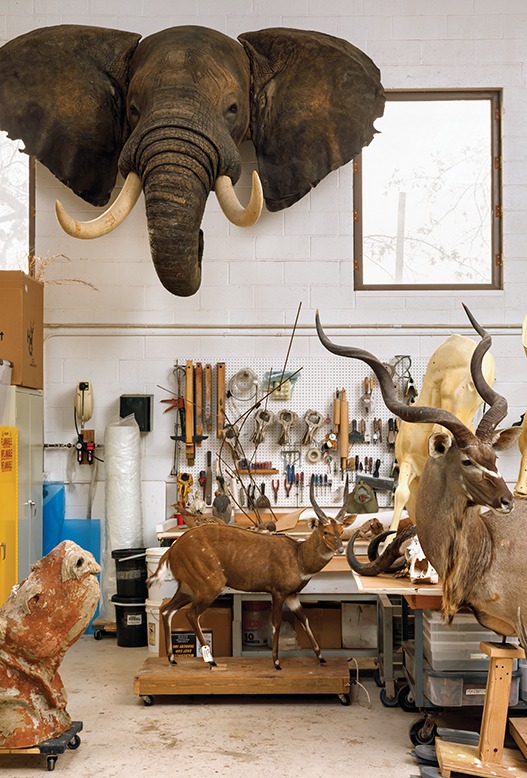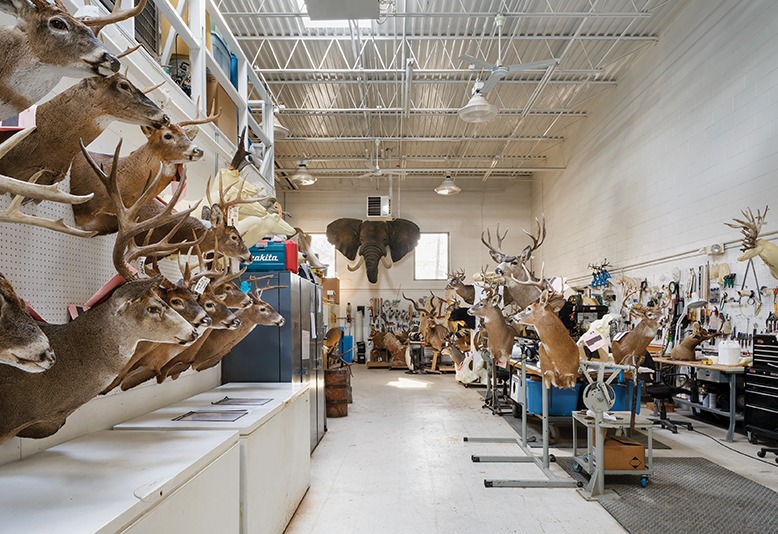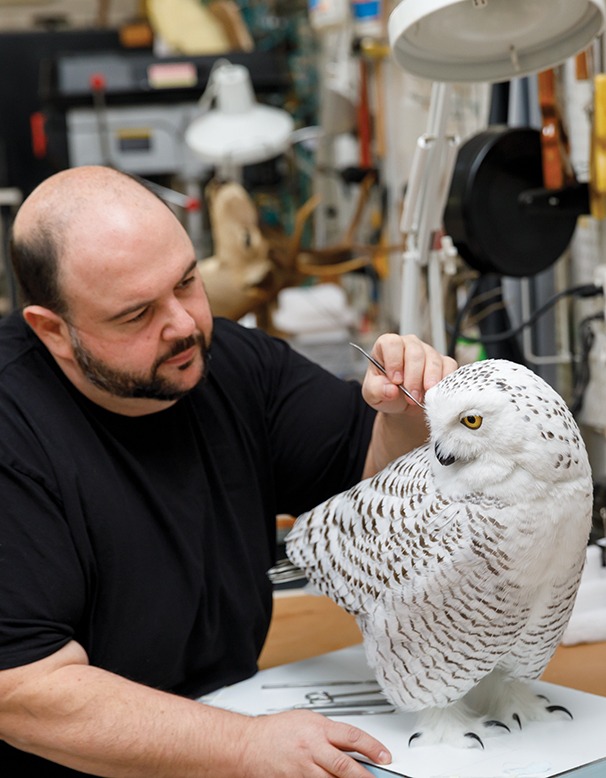
If you’re a taxidermist, your career highlight might be mounting a black bear or a jaguar. But if you’re George Dante, your career highlight is fashioning an elephant tusk so authentic, it fools Tanzanian game officials. Or mounting Lonesome George, the much-lamented last tortoise of his breed.
“He’s probably the most talented taxidermist in the world,” says Jennifer Sontchi, senior director of exhibits and public spaces for the Academy of Natural Sciences at Drexel University in Philadelphia. “You don’t get the Lonesome George job unless nobody else will do.”
Though Dante’s creations are on display in elite institutions like the American Museum of Natural History in New York, Chicago’s Field Museum, and the Smithsonian, he works in a nondescript storefront in an industrial center in Woodland Park. The studio looks like a typical artist’s workspace—except for the deer heads and other evidence of Dante’s trade. Enlarged black-and-white photos of taxidermy’s forefathers stare down from above his desk. A poster-size framed National Geographic cover featuring his elephant tusk adorns another wall. The bookcase is filled with taxidermy-supply catalogs selling handmade glass eyes and manikins—artists’ dummies—in various animal shapes and poses.

The 400-pound elephant head in Dante’s studio is being stored for a private client. Below it, a bushbuck antelope, left, and a greater kudu await restoration. Photo by Colin Miller
Dante’s first office and studio, though, was in his parents’ Totowa basement. There, he mounted his earliest specimen at age seven—a fish he caught in Barnegat Bay. By high school, he had started his company, Wildlife Preservations, mounting fish and animals for local sportsmen. Dante continued the work while enrolled at the School of Visual Arts. Yes, there are taxidermy schools. But Dante didn’t think he could earn a living from the craft.
As a graduating senior, Dante received job offers in stop-motion animation and children’s-book illustration. Instead, he decided, “I’d rather do taxidermy in my parents’ basement.”
In 2003, seven years after Dante graduated college, an exhibits specialist from the Museum of Natural History visited his basement studio to check out his work. The result? A contract taxidermist position in the Hall of Ocean Life. That led to restoration work in the North American Mammal Hall. “Being able to go inside the dioramas was unreal,” says Dante, who fondly recalls childhood visits to the museum. “I’d stand inside the diorama and think, “How the hell did I get here?””

Deer heads that Dante is mounting for various clients appear to gaze out from his studio wall. Dante is called on to do work for museum exhibits as well as private collections. Photo by Colin Miller
It was the museum of Natural History connection that led to Dante mounting Lonesome George after the reptile’s 2012 death. More than 100 years old, Lonesome George was a global symbol of biodiversity, the last remaining Pinta Island tortoise. (Pinta is the northernmost of the major Galapagos islands.) When asked if he wanted to take on the project, he says, “I had to think about it for all of 30 seconds.” He knew the pressure would be on. “There were scientists who worked with him for 40 years,” says Dante. “It’s like a member of their family.”
Still, the techniques were standard. Dante measured and photographed the tortoise. His crew took reference casts and molds of his body and shell. They removed his skin, tanning and preserving it. Dante sculpted an armature as the body base.
Dante has no clue how many hours he spent on Lonesome George. The yearlong project started and stopped while experts popped into his studio to ensure accuracy. “Every step of the way, we had to get approvals. There was no room for error.” The scientists knew Lonesome George’s postures, expressions, how the skin folds looked when he stood a certain way, and where dirt lodged in his toes. “It was an honor to see their reactions when it was done. People cried. It was a very surreal moment for me.”
[RELATED: The Poignant Stories Behind 3 Local Animal Sanctuaries]
Lonesome George’s original mold is still perched above the rear door in Dante’s 4,000-square-foot warehouse studio. It’s covered in plastic, like luggage in a garage. At the top of a two-story shelving unit, four of the mold’s “positives” are stacked two by two, just in case they’re ever needed. The shelves also hold blue, air-tight barrels with cleaned and folded animal skins. Clear plastic bins contain dried, pressed plants used in habitat creations.
Dante apologizes for the state of his studio; he recently added a partial second floor for his new nonprofit. He’s collecting historic taxidermy manikins, dioramas and other objects to show how the field has changed through the years.
However, aside from a large pile of manikins and a table full of recreated animal parts awaiting sorting, Dante’s studio is well organized and clean. Most of his work is for museums. But he still has private clients who want their trophy animals mounted or taxidermy collections restored. The back wall, above the area used for mold making, welding and woodworking, holds an enormous elephant head. It’s not his work, but who else could safely store it while the owner moves to a new house?
***
Dante sometimes works on-site. He recently restored Chinese takins (a goat-like animal) and lowland gorillas from two of Drexel’s 1930s dioramas, donning a respirator and hazmat suit to remove them. “His work is unbelievably good,” Sontchi says. “It’s magical what he can do to decades-old taxidermy, let alone new taxidermy.”
Taxidermists usually just use the animal’s skin. “You’re making a form of beef jerky, a dried animal product. It’s delicious to all kinds of rodents,” Sontchi says. In older taxidermy, arsenical soap was rubbed into the skin, staving off infestations. Toxic chromium-based paints were used as well. Curators must be vigilant against infestations at all times, she says; hence the respirator and other precautions.
Arsenic is the best preservative, but it’s no longer used. As a result, says Dante, “today’s taxidermy may not last as long.”
The process is not as gory as you might think. Many carcasses are processed in the field. In such cases, Dante receives only the preserved, salted skin. He then relaxes and rehydrates the skin to start the tanning process before putting it on the purchased or hand-carved manikin. When receiving the whole specimen, Dante removes the skin without dissecting the animal. He measures the animal before and after the skin removal, sometimes casting the corpse, feet and nose, and making a death mask.
Most of the mounted animal parts are artificial. The skull and skeleton may be kept for reference or a museum collection drawer, or mounted for rearticulation. The mounting usually just includes the fur and antlers, if the animal has them. With birds, Dante may use the skull, leg and wing bones.

Dante uses a dental probe to put the final touches on a snowy owl he fabricated from artificial parts. Photo by Colin Miller
Today’s less toxic taxidermy is touchable. Dante’s two daughters, ages 4 and 6, get excited coming to the office. “They like to see what new animals we have,” he says. “You can’t touch most animals in the zoo, but here, you can touch them or stand under them.” Dante’s storage room resembles a mini museum with frequently changing exhibits. In October, it held a polar bear, an African lion, a restored 50-year-old leopard, a monkey clinging to a branch while tucked into a plastic tote, and a mounted bulldog head.
No two workdays are the same. When museums are flush with funding, Dante builds new exhibits and restores previously mounted animals. He has a year’s worth of projects, about 400, in the pipeline. Most projects are completed within a year. The standard deer heads cost $850 to mount, but most clients want higher-priced, customized work. Dante shows a current project sketch: a habitat featuring a black bear and otter, for $15,000. “This is what they come for,” he says. He’ll construct the foliage and rocks, which sometimes means working with interior designers on color schemes.
Dante’s crew fluctuates, depending on the projects. During the pandemic, he has one full-time and two part-time staff members. But for large museum contracts, he hires sculptors, mold makers and others in the special-effects industry.
Dante’s work doesn’t neatly fit into a traditional taxidermy definition. He considers himself a sculptor, painter and artist of anything associated with natural history. While he didn’t think any work could match the excitement and prestige of Lonesome George, his National Geographic project did. He was commissioned to create non-ivory elephant tusks encasing GPS transmitters that could pass as the real thing. The tusks were flown to Tanzania and put on the black market to trace the sales routes.
Dante spent weeks researching ivory and historical reproduction methods, making hundreds of samples. National Geographic reporter Bryan Christy told him, “If you screw this up, you’ll get me killed.” Christy didn’t get killed, but he was jailed when Tanzanian wildlife officials accused him of smuggling real ivory. One of Dante’s tusks was featured on the September 2015 National Geographic cover. “For us, that’s like being on the cover of Rolling Stone.”
***
Dante’s studio is not open to the public, but he held occasional workshops there before the pandemic. With his nonprofit, he’ll reprise those workshops. The nonprofit is also an opportunity to preserve and archive historical taxidermy methods. “A lot of these methods are lost,” he says. As dioramas and exhibits age, it’s harder to understand how they were made. “Usually, once the exhibit is over, they trash it.”
The collection includes a headless deer rescued by David Schwendeman’s studio from the Museum of Natural History dumpster. “The museum would cut up the specimens,” he says. “For us, it’s great as a teaching aide.” Dante also has a partial diorama once destined for the museum’s trash.
Dante plans to hold educational programming for museum professionals and conservators.
Drexel’s Sontchi feels fortunate that one of the world’s top taxidermists is just one state away. “There are only a couple of people who do this kind of work,” she says. “He’s the guy you want with a priceless exhibit that can’t be replicated.”
Deborah Abrams Kaplan is a Westfield-based freelance writer. She visited Pinta Island several weeks after the death of Lonesome George.
